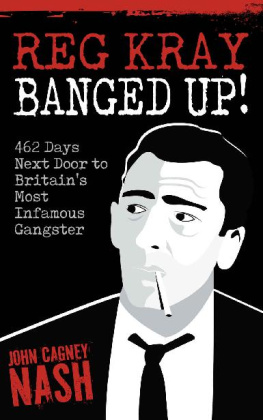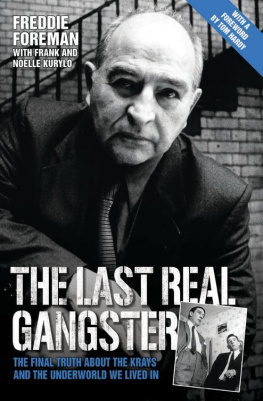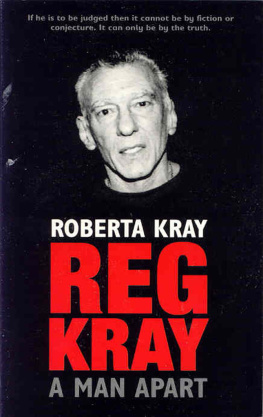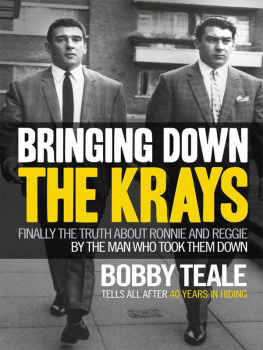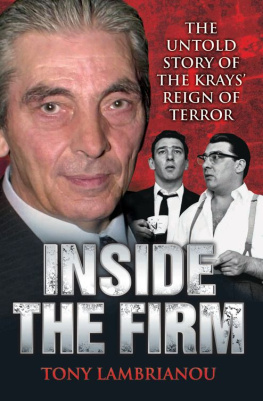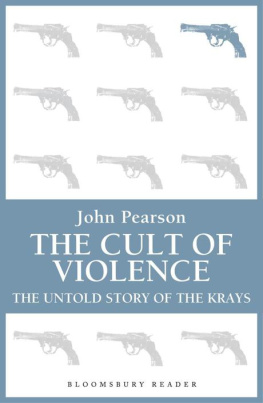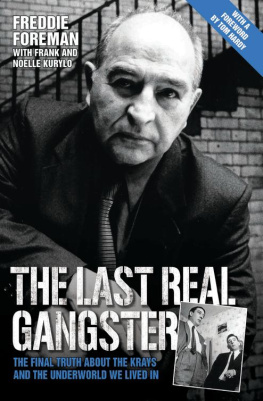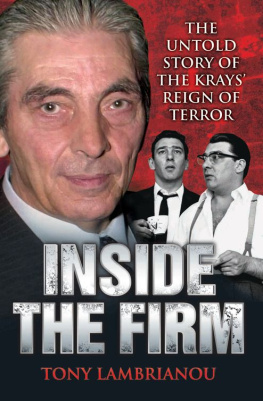REG KRAY - BANGED UP!
462 Days Next Door to Britains Most Infamous Gangster
John Cagney Nash
This edition published worldwide by:
4A
Wembury Mews, Highgate
London N6 5XJ
4APublishing.com
Content copyright John Cagney Nash, 2019
Illustrations copyright 4A Publishing, 2019
All rights reserved. No element of this work may be reproduced, stored in a retrieval system or transmitted by any means extant including but not limited to digital, electronic, mechanical, printing and/or sound recording or by any means as yet to be developed, without prior written consent from the publisher.
The right of John Cagney Nash to be identified as the author of this work has been asserted by him in accordance with the U.K. Copyright, Designs and Patents Act 1988, and in accordance with the Copyright Act of 1976, codified in Title 17 of the United States Code.
A CIP record of this book is available from the British Library.
Date of first publication: January 2019.
Layout and design by 4A Publishing.
ISBN 978-1-68454-162-1

Arc in Synopsis
Prolog: Introducing Essayist and Essay; Becoming Reggie Krays Next-Door Neighbor
Distinguishing author from Islington mob boss Johnny Nash; using that twist to introduce fifties gangland London. Genesis of work; narrative structure; appending postcodes to enable tour-taking. This runaway teens earliest experience of Londons East End; finding magic and magnetic charisma in the most unlikely of places; violence and doorwork as antidote to one-dimensional, ordinary life. The Krays epitomizing moods of electric villainy.
Asides on Christine Keeler and Henry Cooper, on celebrity friends setting the Krays apart, on the improbable power of gash, on sports and crime being the only viable routes out of East End insolvency, and on embracing both opportunity and compliment when they come along.
Chapter 1: Relevance of the East Ends Past, and Ubiquity of Violence
Frances Sheas life, marriage and death; the impact of her suicide; incompatibilities between sex and adoration. Reggies losing himself in writing, and its ancillary effect of anchoring identity; gauging outside society by the deteriorating caliber of cons encountered; loyalty, friendship and a reputation for reserve. Movie stars and high-n-mighties; legitimate business; bureaucratic cowards and red-tape direktorates forcing a return to racketeering.
Asides on kids absorbing cultures which equate winning with strength, and losing with weakness, on riding Ghost Trains and Busty Babs Windsor, on the Regal, on how Esmeraldas Barn almost broke the twins, and on the enormous gulf between Londons districts.
Chapter 2: Night of the Bomb, and Subsequent Earliest Attitudes to Authority
World War IIs establishing no one is safe from tyrants; how societys merciless regimes use violence to dismantle ordinary lives, for profit; the twins army experience confirming all governance invariably compels cooperation through fear; peoples need for an entity with which to butt heads. Both Krays initial arrests being incidences of grotesque overreaction; forming their first Firm; networking Londons underworld and learning protections intricacies.
Asides on the normalcy of East End mens refusal to be conscripted, on No Grassing as doctrine, and on the wisdom of exporting successful formul from poor neighborhoods to those where already-rich targets would do anything in expectation of becoming more so.
Chapter 3: Carry On Uninterrupted
Ronnie, Boothby and Driberg; Scotland Yards mid-64 dossier vetoed by Downing Street; years thus safe from police, press and parliamentary aegis; the Krays American mafia connection; putting historys first chinks in the twins armor. Met police resuming official Kray inquiries; an abortive hit on Leslie Payne, and resultant statements divulging every dirtily-done deal; convincing A-list insiders to cooperate; Ronnies acumen killing off Esmeraldas.
Asides on Ronnies nutting-off in 56 and the notorious Twin Swap, on Hew McCowan and his Hideaway, on Cooper, Kaufman and Laurie OLeary, on Ronnie in NYC, on that Charlie Martin bayonet incident, and on four locations every reader needs at least elfin foreknowledge of.
Chapter 4: Hoisters of Their Own Petard; the Downside of Celebrity
Joey Pyle, Wilf Pine and Tommy Smithson; lawbreakers as Local Hero antiheroes, and their enemys need for high-visibility object lessons in reasserting dominance. The twins love of unwise attention-seeking; that lust for eminence ensuring they became plods primary targets. Mr Smiths; George Cornell as perfect Kray nemesis; the Beggars, and all players precise movements thereafter; Jack McVitie, and both Krays admitting theyd felt exposed on-street; Reggies demon-haunted day-to-day of slow-building subterranean pressure.
Asides on Charlie Richardsons involvement with Britains royalty, on Princess Margarets massive appetite for gangster dick and Polaroids of her pulling trains, and on 1971s MI5 raid at Lloyds Baker Street branch, recovering said photos of nobility being gangbanged.
Chapter 5: Arrest, Remand and the 1969 Old Bailey Trial
Mets mass swoop; Braithwaite House described; itineraries of Reg and Ronnies last night at large, then post-arrest. Nippers deal with Firm informers; the Krays wall of silence crumbles; a full roll of shame identifying every grass, their involvements and impacts (including some surprises); the true identity of Blind Beggar barmaid Mrs X; an actual, current address for supergrass Bobby Teale. Honorable mentions of those who never cracked. Press coverage and motorcades; massaging defeat and perceived humiliation into iconic reputations.
Asides on why the twins seldom drove themselves, on World War IIs evacuation, on The Brooks at Bildeston and firebug Geoff Allen, on London safehouses, on honor amongst thieves, on their Mad Axeman escapade, and on what became of crimes massive proceeds.
Chapter 6: Confronting a Life Sentence; the Experience of Imprisonment
The purely notional end to a thirty-year sentence; Reg doped-up on chemical coshes; confronting faggotry and cultivating sissy mafiosi. Categorical confirmation Reg always expected early release; learning skills from new intakes to use in a future of freedom; detonating chances of parole by showing zero contrition for actions carried out in cold blood. Reinventing events according to cosmetic Kray recoding; further damage done by documentaries, movies and books; some momentum, nonetheless, toward discharge.
Asides on sex lives, on Ronnies fog of anesthetized, docile acceptance, on balancing a need to remain aloof with the usefulness of star-struck sycophants, on Reggies fascination with big supermarkets really humanizing the man, and on Parkhursts irredeemable history.
Chapter 7: Beginnings, Endings and the Sayings of Goodbye
Putting A-Cat pokeys in the past; jeopardy created by being Reg Kray, but freedoms posing greater threats; why both twins wouldve died within months had they not been arrested. How the Firm may have handled shifts from traditional cash-based profiteering to electronic money transfers; Brother Charlie given a death sentence in Fortress Parkhurst; living through that tragedy as Reggies next-door neighbor; Ronnies and then Brother Charlies send-offs.
Asides on the twins moral compasses, on wholesale drug peddling, on Brother Charlies satellite life (apparent playboy, in-pub anecdotist and doing the dumbest coke deal in history), on psychological exploitation of Violets funeral, and on Reg and Ronnies visits.
Chapter 8: Older and Smarter; Reggies Attitude to Other Inmates and Old Enmities
The madness of petty criminals feeding systems theyre supposed to hate. How life inside seemed ordinary to Reg; inferring lessons hed learned; Hell is other people, and internal shutting down; Radio Rentals Radar. Unlikely alliances with Charlie and Eddie Richardson; summits at the Astor then at Maidstone nick. The biggest lesson Reg learned inside thats transferable to free life; his eager hopes of identifying a bigger-picture purpose.
Next page
